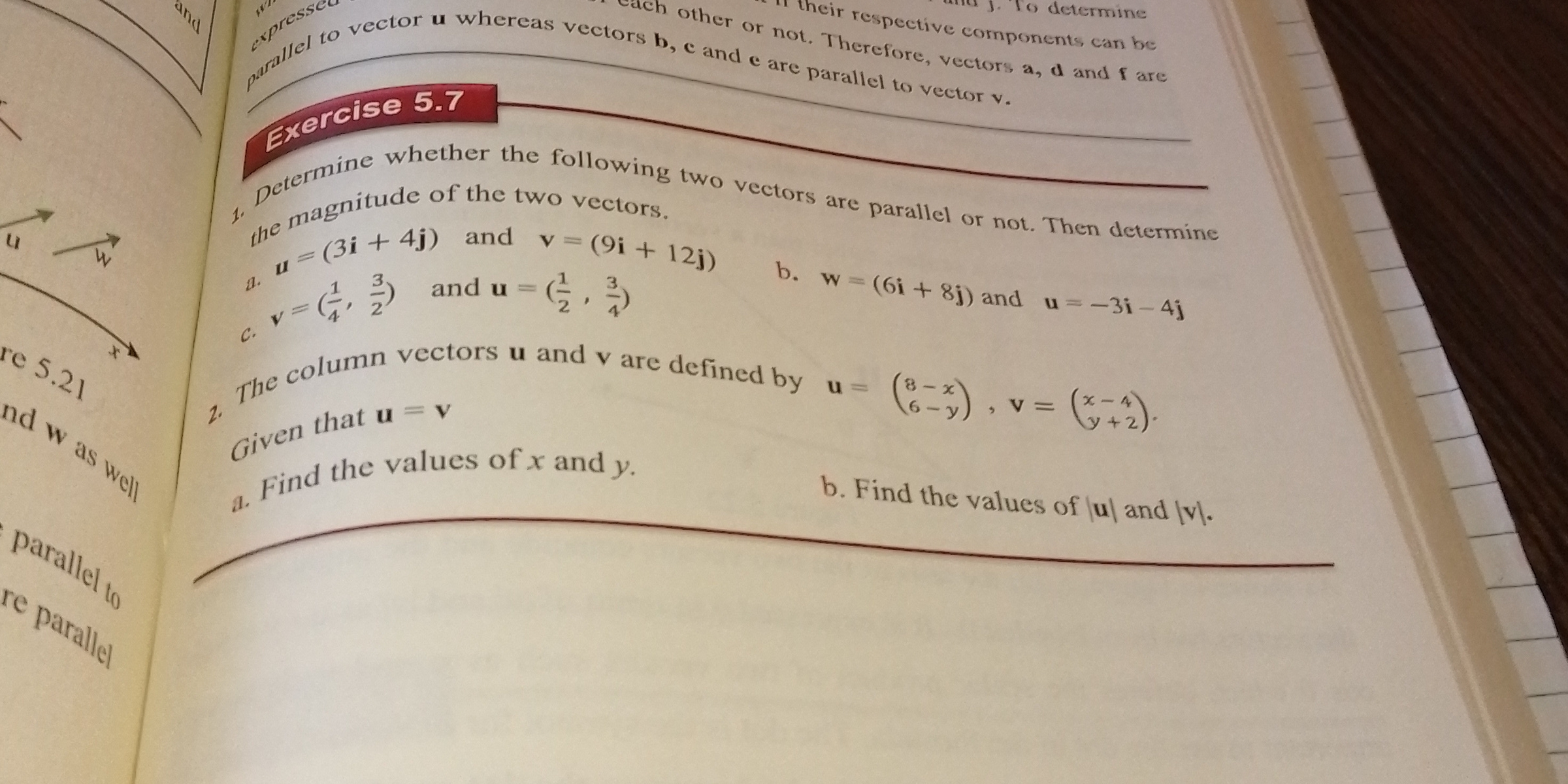Exercise 5.7 1. Determine whether the following two vectors are parallel or not. Then determine the magnitude of the two vectors. a. u = (3i + 4j) and v = (9i + 12j) b. w = (6i + 8... Exercise 5.7 1. Determine whether the following two vectors are parallel or not. Then determine the magnitude of the two vectors. a. u = (3i + 4j) and v = (9i + 12j) b. w = (6i + 8j) and u = -3i - 4j c. v = (1/4, 3/2) and u = (1/2, 3/4) 2. The column vectors u and v are defined by u = ((8-x),(6-y)), v = ((x-4),(y+2)). Given that u = v a. Find the values of x and y. b. Find the values of |u| and |v|.

Understand the Problem
The image contains two vector problems. The first is determining whether two vectors are parallel or not, then calculating the magnitude of them. The second is given that u=v, find the values of x and y, and the magnitudes of u and v.
Answer
a. $x = 6$, $y = 2$ b. $|\mathbf{u}| = 2\sqrt{5}$, $|\mathbf{v}| = 2\sqrt{5}$
Answer for screen readers
a. $x = 6$, $y = 2$ b. $|\mathbf{u}| = 2\sqrt{5}$, $|\mathbf{v}| = 2\sqrt{5}$
Steps to Solve
-
Solve for $x$ Since $\mathbf{u} = \mathbf{v}$, we can set the corresponding components equal to each other. So, $8 - x = x - 4$. Now, adding $x$ and $4$ to both sides, we have $12 = 2x$. Finally, dividing by 2, we get $x = 6$.
-
Solve for $y$ Similarly, we have $6 - y = y + 2$. Adding $y$ and subtracting $2$ from both sides, we have $4 = 2y$. Dividing by 2, we get $y = 2$.
-
Find the vector $\mathbf{u}$ Substitute $x = 6$ and $y = 2$ into the expression for $\mathbf{u}$: $\mathbf{u} = \begin{pmatrix} 8 - x \ 6 - y \end{pmatrix} = \begin{pmatrix} 8 - 6 \ 6 - 2 \end{pmatrix} = \begin{pmatrix} 2 \ 4 \end{pmatrix}$.
-
Find the vector $\mathbf{v}$ Substitute $x = 6$ and $y = 2$ into the expression for $\mathbf{v}$: $\mathbf{v} = \begin{pmatrix} x - 4 \ y + 2 \end{pmatrix} = \begin{pmatrix} 6 - 4 \ 2 + 2 \end{pmatrix} = \begin{pmatrix} 2 \ 4 \end{pmatrix}$.
-
Calculate the magnitude of $\mathbf{u}$ The magnitude of a vector $\begin{pmatrix} a \ b \end{pmatrix}$ is given by $\sqrt{a^2 + b^2}$. So, $|\mathbf{u}| = \sqrt{2^2 + 4^2} = \sqrt{4 + 16} = \sqrt{20} = 2\sqrt{5}$.
-
Calculate the magnitude of $\mathbf{v}$ Similarly, $|\mathbf{v}| = \sqrt{2^2 + 4^2} = \sqrt{4 + 16} = \sqrt{20} = 2\sqrt{5}$.
a. $x = 6$, $y = 2$ b. $|\mathbf{u}| = 2\sqrt{5}$, $|\mathbf{v}| = 2\sqrt{5}$
More Information
The magnitudes of $\mathbf{u}$ and $\mathbf{v}$ are equal, as expected, since $\mathbf{u} = \mathbf{v}$.
Tips
A common mistake is to make errors during algebraic manipulation when solving for $x$ and $y$. Carefully check your steps when rearranging the equations. Also, ensure you substitute the correct values of $x$ and $y$ when finding the vectors $\mathbf{u}$ and $\mathbf{v}$.
AI-generated content may contain errors. Please verify critical information